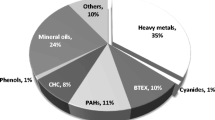Abstract
Dehydrogenase activity is frequently used to assess the general condition of microorganisms in soil and activated sludge. Many studies have investigated the inhibition of dehydrogenase activity by various compounds, including heavy metal ions. However, the time after which the measurements are carried out is often chosen arbitrarily. Thus, it can be difficult to estimate how the toxic effects of compounds vary during the reaction and when the maximum of the effect would be reached. Hence, the aim of this study was to create simple and useful mathematical model describing changes in dehydrogenase activity during exposure to substances that inactivate enzymes. Our model is based on the Lagergrens pseudo-first-order equation, the rate of chemical reactions, enzyme activity, and inactivation and was created to describe short-term changes in dehydrogenase activity. The main assumption of our model is that toxic substances cause irreversible inactivation of enzyme units. The model is able to predict the maximum direct toxic effect (MDTE) and the time to reach this maximum (TMDTE). In order to validate our model, we present two examples: inactivation of dehydrogenase in microorganisms in soil and activated sludge. The model was applied successfully for cadmium and copper ions. Our results indicate that the predicted MDTE and TMDTE are more appropriate than EC50 and IC50 for toxicity assessments, except for long exposure times.






Similar content being viewed by others
References
Akmal M, Wang H, Wu J, Xu JM, Xu DF (2005) Changes in enzymes activity, substrate utilization pattern and diversity of soil microbial communities under cadmium pollution. J Environ Sci (China) 17:802–807
Aksu Z (2001) Equilibrium and kinetic modelling of cadmium (II) biosorption by C. vulgaris in a batch system: effect of temperature. Sep Purif Technol 21:285–294
Al-Qodah Z (2006) Biosorption of heavy metal ions from aqueous solutions by activated sludge. Desalination 196:164–176
Anderson K, Koopman B, Bitton G (1988) Evaluation of int-dehydrogenase assay for heavy metal inhibition of activated sludge. Water Res 22:349–353
Baas J, Jager T, Koojman B (2010) Understanding toxicity as processes in time. Ecotoxicology 408:3735–3739
Bååth E (1989) Effects of heavy metals in soil on microbial processes and populations (a review). Water Air Soil Pollut 47:335–379
Bitensky MW, Yielding KL, Tomkins GM (1965) Reciprocal changes in alanine and glutamate dehydrogenase activities after exposure of crystalline bovine L-glutamate dehydrogenase to organic mercury. J Biol Chem 240:663–667
Cabrero A, Fernandez S, Mirada F, Garcia J (1998) Effects of copper and zinc on the activated sludge bacteria growth kinetics. Water Res 32:1355–1362
Calabrese EJ, Baldwin LA (2002) Defining hormesis. Hum Exp Toxicol 21:91–97
Calabrese EJ, Blain RB (2009) Hormesis and plant biology. Environ Pollut 157:42–48
Canesi L, Ciacci C, Piccoli G, Stocchi V, Viarengo A, Gallo G (1998) In vitro and in vivo effects of heavy metals on mussel digestive gland hexokinase activity: the role of glutathione. Comp Biochem Physiol C 120:261–268
Casida LE, Klein DA, Santoro T (1964) Soil dehydrogense activity. Soil Sci 98:371–376
Chander K, Brookes PC (1991) Is the dehydrogenase assay invalid as a method to estimate microbial activity in copper-contaminated soils? Soil Biol Biochem 23:909–915
Chaperon S, Sauvé S (2008) Toxicity interactions of cadmium, copper, and lead on soil urease and dehydrogenase activity in relation to chemical speciation. Ecotoxicol Environ Saf 70:1–9
Chrestensen CA, Starke DW, Mieyal JJ (2000) Acute cadmium exposure inactivates thioltransferase (Glutaredoxin), inhibits intracellular reduction of protein-glutathionyl-mixed disulfides, and initiates apoptosis. J Biol Chem 275:26556–26565
Corner EDS, Sparrow BW (1956) The modes of action of toxic agents. I. Observations on the poisoning of certain crustaceans by copper and mercury. J Mar Biol Assoc UK 35:531–548
De Coen WM, Vangheluwe ML, Janssen CR (1998) The use of biomarkers in Daphnia magna toxicity testing. III. Rapid toxicity testing of pure chemicals and sediment pore waters using ingestion and digestive enzyme activity. Chemosphere 37:2677–2694
De Coen WM, Janssen CR, Segner H (2001) The use of biomarkers in Daphnia magna toxicity testing V. In vivo alterations in the carbohydrate metabolism of Daphnia magna exposed to sublethal concentrations of mercury and lindane. Ecotoxicol Environ Saf 48:223–234
Gadd GM (1990) Heavy metal accumulation by bacteria and other microorganisms. Experientia 46:834–840
Griebe T, Schaule G, Wuertz S (1997) Determination of microbial respiratory and redox activity in activated sludge. J Ind Microbiol Biotechnol 19:118–122
Jager T (2014) Build Your Own Model (BYOM) version 1.5. http://debtox.info/byom.html. Accessed 01 May 2014
Jay D, Zamorano R, Muñoz E, Gleason R, Boldu JL (1991) Study of the interaction of cadmium with membrane-bound succinate dehydrogenase. J Bioenerg Biomembr 23:381–389
Kao WC, Huang CC, Chang JS (2008) Biosorption of nickel, chromium and zinc by MerP-expressing recombinant Escherichia coli. J Hazard Mater 158:100–106
Katayama-Hirayama K (1986) Inhibition of the activities of β-galactosidase and dehydrogenases of activated sludge by heavy metals. Water Res 20:491–494
Khan S, Cao Q, Hesham AE-L, Xia Y, He JZ (2007) Soil enzymatic activities and microbial community structure with different application rates of Cd and Pb. J Environ Sci (China) 19:834–840
Kizilkaya R (2008) Dehydrogenase activity in Lumbricus terrestris casts and surrounding soil affected by addition of different organic wastes and Zn. Bioresour Technol 99:946–953
Kooijman SALM, Bedaux JJM (1996) Analysis of toxicity tests on Daphnia survival and reproduction. Water Res 30:1711–1723
Lagergren S (1898) Zur theorie der sogenannten adsorption geloester stoffe. K Sven Vetenskapsakademiens Handl 24:1–39
Landi L, Renella G, Moreno JL, Falchini L, Nannipieri P (2000) Influence of cadmium on the metabolic quotient, L-:d-glutamic acid respiration ratio and enzyme activity: microbial biomass ratio under laboratory conditions. Biol Fertil Soils 32:8–16
Letelier ME, Lepe AM, Faúndez M, Salazar J, Marín R, Aracena P, Speisky H (2005) Possible mechanisms underlying copper-induced damage in biological membranes leading to cellular toxicity. Chem Biol Interact 151:71–82
Letelier ME, Martínez M, González-Lira V, Faúndez M, Aracena-Parks P (2006) Inhibition of cytosolic glutathione S-transferase activity from rat liver by copper. Chem Biol Interact 164:39–48
Letelier ME, Lagos F, Faúndez M, Miranda D, Montoya M, Aracena-Parks P, González-Lira V (2007) Copper modifies liver microsomal UDP-glucuronyltransferase activity through different and opposite mechanisms. Chem Biol Interact 167:1–11
Letelier ME, Faúndez M, Jara-Sandoval J, Molina-Berríos A, Cortés-Troncoso J, Aracena-Parks P, Marín-Catalán R (2009) Mechanisms underlying the inhibition of the cytochrome P450 system by copper ions. J Appl Toxicol 29:695–702
Letelier ME, Sánchez-Jofré S, Peredo-Silva L, Cortés-Troncoso J, Aracena-Parks P (2010) Mechanisms underlying iron and copper ions toxicity in biological systems: pro-oxidant activity and protein-binding effects. Chem Biol Interact 188:220–227
Mahmoud NS, Ghaly AE (2004) Influence of temperature and pH on the nonenzymatic reduction of triphenyltetrazolium chloride. Biotechnol Prog 20:346–353
Małachowska-Jutsz A, Matyja K (2010) Wpływ wybranych soli miedzi na aktywność dehydrogenaz mikroorganizmów osadu czynnego. Przem Chem 89:1082–1086
Małachowska-Jutsz A, Matyja K (2011) Wpływ wybranych soli kadmu na aktywność dehydrogenaz mikroorganizmów osadu czynnego. Przem Chem 90:1551–1554
Małachowska-Jutsz A, Matyja K, Ziembińska A (2011) Cadmium and copper toxicity assessment in activated sludge using TTC bioassay. Arch Environ Prot 37:85–94
Masciandaro G, Ceccanti B, Ronchi V, Bauer C (2000) Kinetic parameters of dehydrogenase in the assessment of the response of soil to vermicompost and inorganic fertilisers. Biol Fertil Soils 32:479–483
Mattson MP (2008) Hormesis defined. Ageing Res Rev 7:1–7
Moreno JL, García C, Landi L, Falchinib L, Pietramellarab G, Nannipieri P (2001) The ecological dose value (ED50) for assessing Cd toxicity on ATP content and dehydrogenase and urease activities of soil. Soil Biol Biochem 33:483–489
Nordberg GF, Fowler BA, Nordberg M, Friberg L (eds) (2008) Handbook of the toxicology of metal, 3rd edn. Academic Press, London
Obbard JP (2001a) Measurement of dehydrogenase activity using 2-p-iodophenyl-3-p-nitrophenyl-5-phenyltetrazolium chloride (INT) in the presence of copper. Biol Fertil Soils 33:328–330
Obbard JP (2001b) Ecotoxicological assessment of heavy metals in sewage sludge amended soils. Appl Geochem 16:1405–1411
Oliveira A, Pampulha ME (2006) Effects of long-term heavy metal contamination on soil microbial characteristics. J Biosci Bioeng 102:157–161
Owens TG, King FD (1975) The measurement of respiratory electron-transport-system activity in marine zooplankton. Mar Biol 30:27–36
Pamukoglu MY, Kargi F (2007) Copper(II) ion toxicity in activated sludge processes as function of operating parameters. Enzyme Microb Technol 40:1228–1233
Robinson NJ, Whitehall SK, Cavet JS (2001) Microbial metallothioneins. Adv Microb Physiol 44:183–213
Schützendübel A, Polle A (2002) Plant responses to abiotic stresses: heavy metal-induced oxidative stress and protection by mycorrhization. J Exp Bot 53:1351–1365
Shen G, Cao L, Lu Y, Hong J (2005a) Influence of phenanthrene on cadmium toxicity to soil enzymes and microbial growth. Environ Sci Pollut Res Int 12:259–263
Shen G, Lu Y, Zhou Q, Hong J (2005b) Interaction of polycyclic aromatic hydrocarbons and heavy metals on soil enzyme. Chemosphere 61:1175–1182
Simčič T, Brancelj A (2004) Respiratory electron transport system (ETS) activity as an estimator of the thermal tolerance of two Daphnia hybrids. J Plankton Res 26:525–534
Simčič T, Lukancic S, Brancelj A (2005) Comparative study of electron transport system activity and oxygen consumption of amphipods from caves and surface habitats. Freshw Biol 50:494–501
Stohs SJ, Bagchi D (1995) Oxidative mechanisms in the toxicity of metal ions. Free Radic Biol Med 18:321–336
Veglio F, Beolchini F (1997) Removal of metals by biosorption: a review. Hydrometallurgy 44:301–316
Vig K, Megharaj M, Sethunathan N, Naidu R (2003) Bioavailability and toxicity of cadmium to microorganisms and their activities in soil: a review. Adv Environ Res 8:121–135
Vijver MG, Van Gestel CAM, Lanno RP, Van Straalen NM, Peijnenburg WJ (2004) Internal metal sequestration and its ecotoxicological relevance: a review. Environ Sci Technol 38:4705–4712
Volesky B, Holan ZR (1995) Biosorption of heavy metals. Biotechnol Prog 11:235–250
Wang J, Chen C (2006) Biosorption of heavy metals by Saccharomyces cerevisiae: a review. Biotechnol Adv 24:427–451
Wang J, Chen C (2009) Biosorbents for heavy metals removal and their future. Biotechnol Adv 27:195–226
Yeates GW, Orchard VA, Speir TW, Hunt JL, Hermans MCC (1994) Impact of pasture contamination by copper, chromium, arsenic timber preservative on soil biological activity. Biol Fertil Soils 18:200–208
Zitko V (1979) An equation of lethality curves in test with aquatic fauna. Chemosphere 2:47–51
Acknowledgments
We thank Maria Żytka for her support in model derivation and Przemysław Błasiak for the valuable comments on our manuscript. We would like to thank Editage (www.editage.com) for English language editing. Experiments on activated sludge dehydrogenases activity were funded by Silesian University of Technology, Environmental Biotechnology Department; experiments on soil dehydrogenase activity and language editing were funded by Wrocław University of Technology, Environmental Engineering Faculty.
Author information
Authors and Affiliations
Corresponding author
Ethics declarations
Conflict of interest
The authors declare that they have no conflicts of interest.
Electronic supplementary material
Below is the link to the electronic supplementary material.
Rights and permissions
About this article
Cite this article
Matyja, K., Małachowska-Jutsz, A., Mazur, A.K. et al. Assessment of toxicity using dehydrogenases activity and mathematical modeling. Ecotoxicology 25, 924–939 (2016). https://doi.org/10.1007/s10646-016-1650-x
Accepted:
Published:
Issue Date:
DOI: https://doi.org/10.1007/s10646-016-1650-x




